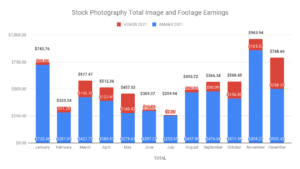Getty Images is a giant in the world of stock photography, serving as a bridge between talented photographers and businesses in need of high-quality images. For many contributors, Getty Images provides an opportunity to monetize their creative work, but understanding the structure of earnings can be a bit complex. In this post, we'll break down how you can benefit from your photography on this platform.
How Getty Images Works for Contributors

Contributing to Getty Images can be an exciting venture for photographers, both amateur and professional. Here’s how the process typically works:
- Application and Acceptance: First, you need to apply as a contributor. This usually involves submitting a portfolio that showcases your best work. If Getty Images is impressed, they’ll invite you to join their contributor network.
- Uploading Your Work: Once accepted, you can start uploading your images. It's essential to upload high-quality, relevant content that meets Getty’s guidelines. Think about current trends and what businesses are looking for.
- Image Metadata: Adding metadata is crucial. This includes titles, descriptions, and keywords that help potential buyers find your images. The right tags can significantly enhance your visibility.
- Licensing Structure: Getty Images uses a complex licensing structure. As a contributor, you can earn royalties based on the type of license buyers select. Typically, images are sold under either © rights-managed or royalty-free licenses. Understanding these can directly impact your earnings.
- Sales and Royalties: When your image sells, you earn royalties. The percentage depends on various factors, including the distribution channel and whether it's exclusive content. It's worth noting that exclusive images can earn more but also come with specific restrictions.
- Promotions and Marketing: Getty Images actively promotes its content, helping contributors reach potential buyers. Participating in Getty-led marketing initiatives can increase the chances of your work being seen.
Additionally, it’s important to keep track of your sales through Getty’s contributor portal. This allows you to see which images are performing well and adjust your strategy accordingly. Regularly analyzing your performance can help you learn what types of images resonate most with buyers, allowing you to create even more in-demand content.
Overall, while the journey as a Getty Images contributor has its challenges, it can also be incredibly rewarding. By putting effort into creating quality work and understanding the platform's intricacies, you can maximize your earnings and build a successful photography business.
Also Read This: Adobe Stock Images Remove Watermark: Online and Offline Methods
3. Factors Influencing Earnings on Getty Images

When it comes to earning money through Getty Images as a contributor, there are several key factors that can significantly influence your earnings. Understanding these can help you strategize and maximize your income. Let’s break it down!
- Content Quality: The quality of your images or videos is paramount. High-resolution, well-composed, and visually appealing content tends to perform better. Invest time in honing your skills and creating stunning visuals to stand out.
- Market Demand: Just like any other market, supply and demand play a significant role. Trends can shift rapidly—what's popular today may not be tomorrow. Keep an eye on trending topics and themes to create relevant content that buyers are looking for.
- Exclusivity: Offering exclusive images can lead to higher earnings. If Getty Images is the only place where buyers can find your work, they may be willing to pay a premium rate for it. This can also enhance your reputation and lead to more opportunities.
- Keywords and Metadata: Properly tagging your images with relevant keywords and metadata can help buyers discover your work. Think about what potential customers might search for and include those terms to improve your visibility.
- Licensing Models: Getty Images offers various licensing models—royalty-free (RF) and rights-managed (RM). Understanding these can help you set appropriate pricing and terms for your content, impacting your earnings.
- Marketing Efforts: Simply uploading your work isn’t enough. Actively marketing your images through social media, personal websites, or blogs can drive traffic and potential buyers to your portfolio on Getty Images.
By paying attention to these factors, you can better position yourself for success on Getty Images. Remember, it's a journey, not a sprint. Continuous improvement and adaptation are key!
Also Read This: Does Getty Images Accept iPhone Photos? Guidelines for Mobile Photography Submissions
4. Typical Pay Rates for Different Types of Content
Understanding the typical pay rates on Getty Images is crucial for contributors, especially when planning what types of content to create. Here's an overview of the earnings you might expect based on different types of images and videos:
| Content Type | Typical Earnings (Per Image) | Fullscreen Video | Premium & Exclusive Content |
|---|---|---|---|
| Standard Images | $50 - $250 | ||
| Editorial Images | $100 - $500 | ||
| Videos (Royalty-Free) | $300 - $1,200 | ||
| Premium Content | $200 - $1,000 | $1,000 - $5,000 | Potentially higher |
Notes: The actual earnings can vary widely based on several factors, including the image's popularity, whether it's purchased as a subscription or a one-off license, and how well it's marketed. Moreover, exclusive content typically garners higher rates. It’s worth diving deep into your offerings to find the niche that works best for you.
In conclusion, while there are typical averages, the sky's the limit with the right approach, content quality, and a little bit of marketing savvy. Keep creating, keep selling, and you’ll see your earnings grow!
Also Read This: Where Getty Images Is Headquartered
5. Tips for Maximizing Earnings as a Contributor
If you're looking to boost your income as a contributor to Getty Images, you’re in the right place! Earning money from stock photography isn’t just about snapping great photos; it involves a combination of strategy, creativity, and a little savvy business sense. Here are some valuable tips to help you maximize your earnings:
- Understand Your Market: Research what types of images are in demand. Browse Getty Images to see which photos get the most traction. Pay attention to trending topics, styles, and themes.
- Diverse Portfolio: Variety is key! Include a mix of subjects in your portfolio. From lifestyle shots to nature scenes to abstract images, broaden your offerings to appeal to a wider audience.
- Quality over Quantity: While it’s great to have a large portfolio, remember that high-quality photos will sell better than a slew of mediocre ones. Invest in good equipment, lighting, and post-editing software to enhance your images.
- Optimize Metadata: Accurately tag your images with relevant keywords and descriptions. This helps customers find your work easily. Think from the buyer's perspective: what would they search for?
- Stay Current: Photography trends evolve. Regularly update your portfolio to reflect current styles and needs in the industry. Don't hesitate to experiment with new techniques or innovative concepts.
- Engage with the Community: Connect with fellow contributors or photographers on platforms like social media or forums. Share insights, tips, and experiences to learn from each other.
- Leverage Social Media: Use platforms like Instagram, Pinterest, or Facebook to showcase your work. Building a following can not only enhance your visibility but also lead to potential sales and collaborations.
By implementing these tips, you can establish a robust presence on Getty Images and significantly enhance your earnings as a contributor. Remember, success doesn't come overnight, but with persistence and smart strategies, you can achieve your financial goals!
Also Read This: How to Register with Getty Images for New Contributors
6. Success Stories from Getty Images Contributors
Everyone loves a good success story, especially when it comes to turning passions into profits. Many contributors to Getty Images have gone from hobbyists to full-time professionals, and their journeys can serve as great inspiration. Here are a few noteworthy success stories that highlight what’s possible with dedication and creativity:
1. Emily's Journey: From Amateur to Professional
Emily started her photography journey as a hobby while traveling. She uploaded a few of her best travel shots to Getty Images, and before she knew it, her photos started selling. Eventually, she made enough to quit her day job and focus solely on photography. Emily attributes her success to:
- Taking advantage of travel opportunities to capture unique images.
- Constantly learning and improving her photography skills.
2. Miguel's Multifaceted Approaches
Miguel, a graphic designer by trade, decided to branch out into photography. He utilized his design skills to create striking composite images that caught the attention of buyers. His secret to success included:
- Creating themed collections of images to appeal to niche markets.
- Networking with other professionals in the industry for collaborations.
3. Sarah's Unconventional Subjects
Sarah took a unique approach by focusing on everyday moments and objects that often go unnoticed. Her ability to find beauty in the mundane allowed her to carve out a niche for herself on Getty Images. Some of her keys to success were:
- Highlighting the importance of storytelling in her images.
- Regularly engaging with her audience to understand their needs.
These contributors demonstrate that with passion, perseverance, and a willingness to adapt, anyone can thrive in the world of stock photography. If you’re ready to start your own success story on Getty Images, take a page from their books: be true to your art, continually seek improvement, and don’t be afraid to think outside the box!
Conclusion: Making the Most of Your Stock Photography Career
To thrive as a contributor on Getty Images, it's essential to leverage every opportunity to maximize your earnings and visibility. Here are some key strategies to consider:
- Quality Over Quantity: Focus on creating high-quality images that meet market demand rather than flooding your portfolio with mediocre shots.
- Understand Trends: Stay updated on current trends in stock photography to shoot images that potential buyers are actively looking for.
- Diversify Your Portfolio: Include various subjects and styles to appeal to a broader audience. Consider categories like:
- Business and finance
- Lifestyles
- Nature and landscapes
- Health and wellness
- Optimize Keywords: Use relevant and popular keywords in your metadata to enhance the discoverability of your images.
- Engage with Your Community: Networking with other photographers and engaging on platforms like social media can lead to collaboration opportunities and valuable feedback.
In conclusion, by focusing on improving the quality of your work, understanding market trends, and effectively marketing your portfolio, you can significantly increase your earnings as a Getty Images contributor. With dedication and strategic planning, your stock photography career can flourish in this competitive space.
 admin
admin








